I’ve always believed that keeping tabs on your health shouldn’t feel like a chore, and that’s exactly why I’m hooked on the Microlife Blood Pressure Monitor. If you’re looking for a reliable, user-friendly way to track your blood pressure at home, this device is a game-changer.
It’s accurate, easy to use, and packed with features that make monitoring your heart health a breeze. Whether you’re managing hypertension or just want peace of mind, the Microlife monitor is a must-have.
Trust me, you’ll wonder why you didn’t get one sooner.
My Journey With The Microlife Blood Pressure Monitor
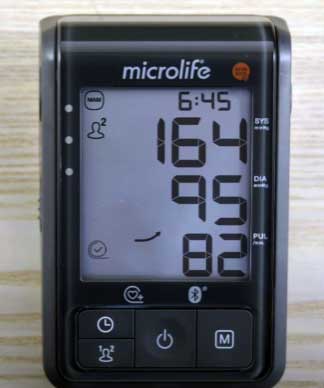
A few months ago, I found myself staring at a doctor’s office blood pressure reading that wasn’t exactly stellar.
My doctor suggested I start monitoring at home to get a clearer picture of my numbers.
I’ll admit, I was a bit overwhelmed at first—there are so many devices out there, and I wasn’t sure where to start.
That’s when I stumbled across the Microlife Blood Pressure Monitor, specifically the BPM6 Premium model, and decided to give it a shot. Spoiler alert: it’s been a total lifesaver.
From the moment I unboxed it, I was impressed. The device is sleek, about the size of a large smartphone, and comes with a sturdy stand that makes it easy to prop up on my kitchen counter.
Setting it up was a breeze—pop in the included AAA batteries, set the date and time, and you’re good to go. I was ready to take my first reading within minutes. The pre-formed cuff, which fits arms from 8.7 to 18.1 inches, was comfortable, though I had to fiddle with it a bit to get it positioned just right above my elbow.
The Quick Start Guide attached to the unit was a nice touch, but I quickly learned that reading the full manual was key to getting accurate results.
Over the next two weeks, I took my blood pressure twice daily, morning and evening, as my doctor recommended. The Microlife BPM6’s large, clear display made it easy to read my systolic, diastolic, and pulse numbers, even without my glasses.
What really stood out was the averaging feature, which takes three readings in a row with short breaks in between and gives you an average. This felt like a more reliable way to track my numbers, especially since blood pressure can fluctuate.
I also loved the little triangle that shows whether your reading is in the normal, borderline, or hypertension zone—it’s like having a mini health coach right there on the screen.
One unexpected perk was the irregular heartbeat detection. During one reading, it flagged an erratic heart rate, which prompted me to take it easy and follow up with my doctor. Thankfully, it was nothing serious, but that feature gave me peace of mind I didn’t even know I needed.
By the end of my trial, I felt more in control of my health, and sharing my stored readings (up to 99 for two users!) with my doctor was a cinch. My experience with the Microlife monitor has been nothing short of empowering, and I’m excited to share the details with you.
The Pros of Choosing Microlife
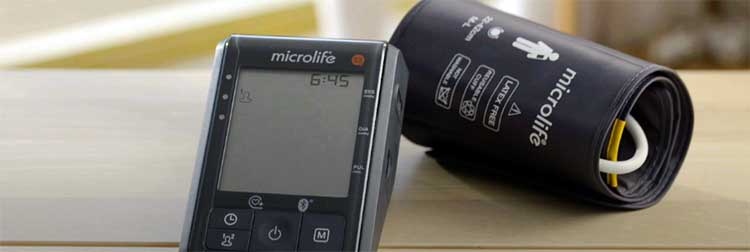
Let’s talk about what makes the Microlife Blood Pressure Monitor shine. I’ve used it for months now, and there are some standout features that keep me coming back to it.
- Clinical-Grade Accuracy You Can Trust
Accuracy is everything when it comes to blood pressure monitors, and Microlife delivers. The BPM6 model I use is validated by the British Hypertension Society, which means it’s been rigorously tested to meet high standards.
I cross-checked my readings with those from my doctor’s office, and they were spot-on, often within a few points. This kind of reliability gives me confidence that I’m getting a true picture of my heart health, which is crucial for anyone managing hypertension or just keeping an eye on things.
- User-Friendly Design for Everyone
I’m no tech wizard, so I appreciate how straightforward the Microlife monitor is. The one-touch start/stop button is a dream, and the large display is easy to read, even in low light. The setup is intuitive, and the included stand keeps the device stable while you’re taking a reading.
Whether you’re tech-savvy or someone who struggles with gadgets, this monitor feels like it was designed with you in mind. My mom, who’s not a fan of complicated devices, tried it and had no trouble at all.
- Advanced Features That Add Value
The Microlife BPM6 isn’t just a basic monitor—it’s got some smart features that make it stand out. The MAM (Microlife Average Mode) technology, which takes three consecutive readings and averages them, is a game-changer for getting a more accurate snapshot of your blood pressure.
The irregular heartbeat detection and hypertension risk indicator are like little safety nets, alerting you to potential issues before they become serious. Plus, the ability to store 99 readings for two users means my partner and I can both track our numbers without needing separate devices.
- Comfortable and Versatile Fit
The pre-formed cuff is a big win in my book. It’s designed to fit a wide range of arm sizes, which makes it versatile for most people. I found it snug but not uncomfortable, and the design helps ensure you’re positioning it correctly for accurate readings.
It’s not perfect—sometimes it takes a bit of adjusting to get it just right—but once you get the hang of it, it’s smooth sailing. This cuff makes the Microlife a great choice for households with multiple users.
- Portability and Durability
I love that the Microlife monitor is compact and battery-powered, so I can take it on the go. I brought it along on a weekend trip, and it fit easily into my bag. The build feels solid, not flimsy, and after months of daily use, it’s still going strong.
The included batteries have lasted longer than I expected, and there’s an option to use an AC adapter if you prefer. It’s a device that feels built to last, which is a huge plus for something you’re using regularly.
The Cons of Microlife Blood Pressure Monitor
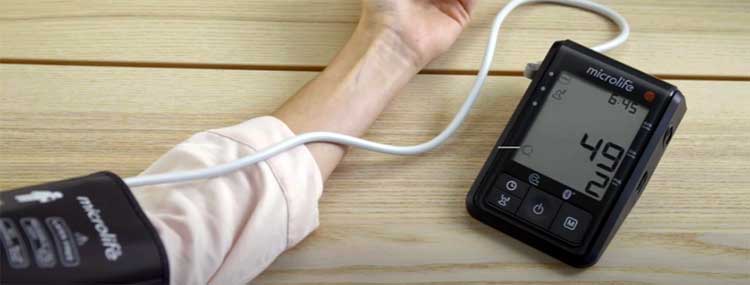
No device is perfect, and the Microlife Blood Pressure Monitor has a few quirks that might give you pause. Here’s what I noticed after using it for a while.
- Cuff Positioning Can Be Tricky
While the pre-formed cuff is generally comfortable, getting it positioned just right can take some practice. The manual emphasizes placing it half an inch to an inch above your elbow and aligning it with your brachial artery.
If you don’t get it spot-on, you might get an inaccurate reading or, worse, the cuff might over-inflate, which happened to me a couple of times. It’s not a dealbreaker, but it can be a bit frustrating until you master the technique.
- No Smartphone App Integration
In a world where everything seems to sync with your phone, the lack of Bluetooth connectivity on the BPM6 model is a bit of a letdown. You can download your readings to a computer using the included USB cable, but it’s not as seamless as syncing to an app.
For someone like me who loves tracking health data on my phone, this feels like a missed opportunity. Some newer Microlife models do offer Bluetooth, but they’re pricier.
- Occasional Inconsistent Readings
While the Microlife is generally accurate, I did notice occasional readings that seemed off. For example, one morning my systolic jumped by 10 points compared to the day before, which felt odd.
After reading the manual, I realized factors like talking, moving, or even having a full bladder can skew results. Using the averaging feature helped smooth things out, but it’s a reminder that you need to follow the instructions carefully to get consistent readings.
- No Backlit Display
The large display is great, but it’s not backlit, which can be a hassle if you’re taking a reading in a dimly lit room. I found myself relying on a lamp for evening measurements, which isn’t ideal.
A backlit display would make the Microlife even more user-friendly, especially for older users or those with vision issues.
Tips To Keep Your Microlife Monitor In Top Shape
Taking care of your Microlife Blood Pressure Monitor is key to ensuring it stays accurate and reliable for years. Here’s how I keep mine in tip-top condition.
- Clean the Cuff Regularly
The cuff is the part that touches your skin, so it’s bound to pick up sweat, dirt, or oils over time. I clean mine every couple of weeks by hand-washing the cuff cover in warm water (about 30°C) with a mild detergent.
Make sure to remove the inner bladder first, as it’s not washable. After washing, I let it air dry completely before reassembling. This keeps the cuff fresh and prevents any buildup that could affect comfort or accuracy.
- Wipe Down the Monitor
The monitor itself doesn’t need much cleaning, but I give it a quick wipe with a slightly damp cloth every month or so to keep it dust-free. Avoid using harsh chemicals or soaking it, as that could damage the electronics.
I also make sure to unplug the cuff and remove the batteries before cleaning to be safe. A clean monitor not only looks better but also ensures the buttons and display stay in good working order.
- Store It Properly
When I’m not using my Microlife monitor, I store it in a cool, dry place away from direct sunlight or extreme temperatures. The included storage bag is handy for keeping everything together and protected.
I also make sure the cuff is loosely folded, not tightly rolled, to prevent creases that could affect its fit. Proper storage helps prolong the life of both the monitor and the cuff.
- Check Battery Life
The Microlife runs on four AAA batteries, and I’ve found they last a surprisingly long time—several months with daily use. Still, I check the battery level every few weeks to avoid interruptions. If the display starts to dim or the device acts sluggish, it’s time for a fresh set.
If you prefer, you can use the optional AC adapter, but I like the portability of batteries. Always remove the batteries if you’re not using the device for a while to prevent corrosion.
- Schedule Regular Accuracy Checks
To keep my monitor accurate, I have it checked every two years or after any significant drops or bumps. Microlife recommends this, and I plan to take mine to a medical equipment supplier for calibration.
In the meantime, I occasionally cross-check my readings with my doctor’s office equipment to ensure they’re still in sync. This extra step gives me confidence that my monitor is performing as it should.
Comparing Microlife To Other Brands
When I was choosing a blood pressure monitor, I explored several brands to see how they stacked up against the Microlife BPM6 Premium. Here’s my take on how it compares to Withings, Medline, Invaxe, and Oklar, based on my research and hands-on experience.
- Microlife Compared To Withings Blood Pressure Monitor
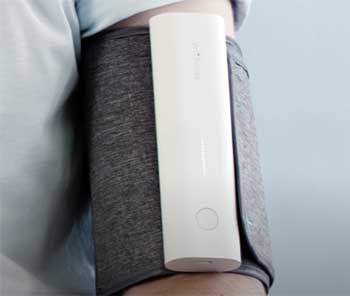
The Withings BPM Connect is a sleek, tech-forward option that caught my attention for its Wi-Fi and Bluetooth connectivity.
I tested it and loved how it syncs effortlessly to the Withings Health Mate app, letting you track trends and share data with your doctor in real time.
The cuff, fitting arms 9 to 17 inches, is soft and easy to position, and the device’s compact design makes it great for travel. However, at around $115, it’s nearly twice the price of the Microlife BPM6, which costs about $60.
Withings lacks the irregular heartbeat detection and averaging technology that Microlife offers, which I found invaluable for spotting potential issues. While Withings excels in app integration, Microlife’s advanced features and lower price make it a better fit for my needs.
- Microlife Compared To Medline Blood Pressure Monitor
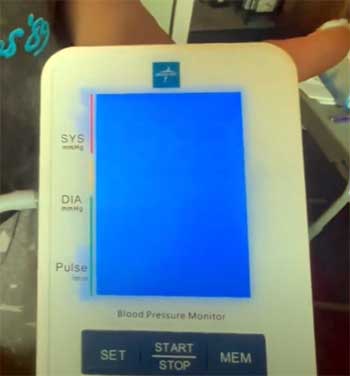
Medline’s blood pressure monitors, like the MDS3001 Plus, are often found in professional settings, so I was curious to try one.
It’s a solid device with a large display and a cuff that fits arms 8.7 to 16.5 inches, similar to Microlife.
I found its one-touch operation simple, and it stores up to 60 readings, but it doesn’t support multiple users like Microlife’s 99 readings for two users.
Priced around $40, it’s cheaper but misses out on Microlife’s MAM technology and hypertension risk indicator.
Medline’s cuff felt a bit stiffer, making it less comfortable for daily use. For home monitoring with extra features, I prefer Microlife’s versatility over Medline’s basic functionality.
- Microlife Compared To Invaxe Blood Pressure Monitor
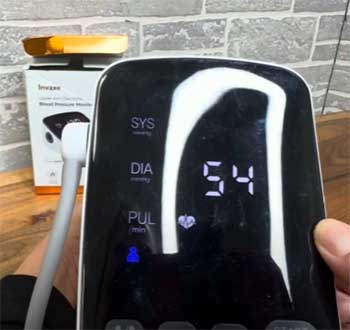
Invaxe is a lesser-known brand, and I tested their upper-arm monitor, which retails for about $35.
It’s budget-friendly and has a clear display, storing up to 90 readings for one user.
The cuff, fitting arms 8.7 to 16.5 inches, was decent but not as snug as Microlife’s pre-formed design.
Invaxe offers irregular heartbeat detection but lacks Microlife’s averaging feature or hypertension indicator, which I found helpful for interpreting readings.
Accuracy-wise, Invaxe was close but occasionally gave readings that seemed off compared to my doctor’s equipment. For reliability and advanced features, Microlife outshines Invaxe, especially for long-term use.
- Microlife Compared To Oklar Blood Pressure Monitor
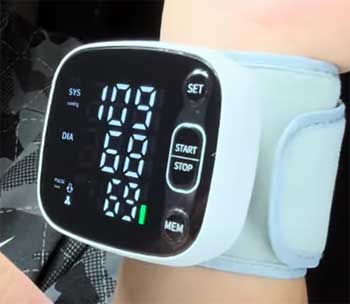
The Oklar C02 Blood Pressure Monitor, priced around $45, is another affordable option I tried.
It has a large display and stores 90 readings for two users, which is solid, and its cuff fits arms 8.7 to 16.5 inches.
I liked its voice function, which reads results aloud—great for visually impaired users—but found it less intuitive than Microlife’s one-touch design.
Oklar includes irregular heartbeat detection but not Microlife’s MAM technology or hypertension risk indicator.
The cuff was comfortable but harder to position correctly. Microlife’s accuracy and extra features make it my go-to over Oklar’s simpler setup.
Frequently Asked Questions (FAQ)
It depends on what you value. Microlife’s BPM6 offers clinical-grade accuracy, irregular heartbeat detection, and a budget-friendly price, making it a fantastic choice for most home users. Omron, like the Platinum model, edges out slightly with Bluetooth and app integration, which is great if you love tracking data on your phone. However, Omron is pricier, and Microlife’s MAM technology and hypertension indicators match or exceed Omron’s features for less. I chose Microlife for its balance of cost and functionality, but if tech is your priority, Omron might have the edge.
Microlife is a Swiss company, founded in 1981 by Dr. Y.T. Wang. Their focus on precision and quality reflects that Swiss reputation for excellence. While some components may be manufactured elsewhere, the design and innovation come straight from Switzerland, which gives me confidence in the brand’s commitment to reliability.
Yes, Microlife monitors can be calibrated, though it’s not something you do at home. The company recommends having your device checked for accuracy every two years or after any significant impact, like a drop. I plan to take mine to a medical equipment supplier for calibration to ensure it stays precise. Regular cross-checking with your doctor’s equipment is also a good way to verify accuracy in the meantime.
Microlife blood pressure monitors are made by Microlife, a Swiss company specializing in medical and home diagnostic devices. Founded in 1981, they’ve built a strong reputation for producing reliable, user-friendly monitors that are trusted by both individuals and healthcare professionals. Their focus on innovation, like MAM and PAD technologies, sets them apart in the health monitoring world.
Final Thoughts On The Microlife Blood Pressure Monitor
If you’re serious about taking charge of your heart health, the Microlife Blood Pressure Monitor is a fantastic investment. It’s accurate, easy to use, and packed with features like irregular heartbeat detection and averaging technology that make it stand out.
For around $60, you’re getting a device that rivals pricier options without breaking the bank. Whether you’re managing hypertension or just want to stay proactive, this monitor has your back. Trust me, you’ll feel empowered knowing your numbers are just a cuff away.
